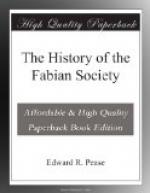“The amendment was carried by 10 votes to 4.
[Presumably the 4 included Burns-Gibson,
Chubb, and Estcourt, who
signed the defeated resolutions.]
“Mr. Podmore’s proposals
were then put forward as substantive
resolutions and considered seriatim.
“Resolution I.—That
the Society be called the Fabian Society (as Mr.
Podmore explained in allusion to
the victorious policy of Fabius
Cunctator) was carried by 9 votes
to 2.
“Resolution II.—That
the Society shall not at present pledge its
members to any more definite basis
of agreement than that contained
in the resolution of 23rd November,
1883.
“Carried unanimously.
“Resolution III.—In place of Mr. Podmore’s first proposal it was eventually decided to modify the resolution of 7th November, 1883, by inserting the words ‘to help on’ between the words ‘shall be’ and the words ‘the reconstruction.’
“Resolution IV with certain
omissions was agreed to unanimously,
viz.: That with the view
of learning what practical measures to take
in this direction the Society should:
“(a) Hold meetings
for discussion, the reading of papers,
hearing of reports, etc.
“(b) Delegate some of its members to attend meetings held on social subjects, debates at Workmen’s Clubs, etc., in order that such members may in the first place report to the Society on the proceedings, and in the second place put forward, as occasion serves, the views of the Society.
“(c) Take measures
in other ways, as, for example, by the
collection of articles from current
literature, to obtain information
on all contemporary social movements
and social needs.
“Mr. Bland, Mr. Keddell, and Mr. Podmore were provisionally appointed as an Executive Committee, to serve for three months, on the motion of Mr. Pease. A collection was made to provide funds for past expenses: the sum collected amounting to 13s. 9d.”
It appears that Mr. Bland on this occasion acted as treasurer, though there is no record of the fact. He was annually re-elected treasurer and a member of the Executive Committee until he retired from both positions in 1911.
Thus the Society was founded. Although it appeared to be the outcome of a division of opinion, this was scarcely in fact the case. All those present became members, and the relations between the Fabian Society and the Fellowship of the New Life were always of a friendly character, though in fact the two bodies had but little in common, and seldom came into contact.
* * * * *
A few words may be devoted to the Fellowship of the New Life, which continued to exist for fifteen years. Its chief achievement was the publication of a quarterly paper called “Seedtime,"[9] issued from July, 1889, to February, 1898. The paper contains articles on Ethical Socialism, the Simple Life, Humanitarianism, the Education of Children, and similar subjects. The Society was conducted much on the same lines as the Fabian Society: fortnightly lectures were given in London and reported in “Seedtime.”




